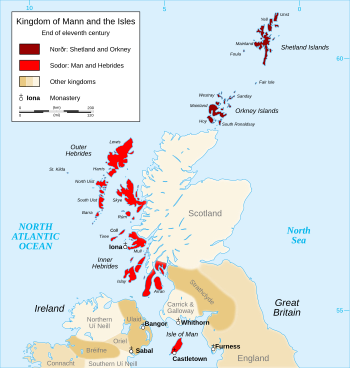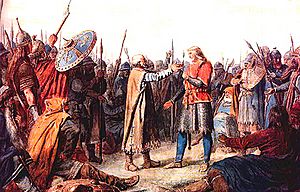Earldom of Orkney facts for kids
Quick facts for kids
Earldom of Orkney
Orkneyjar / Norðreyjar (Old Norse)
|
|||||||||
|---|---|---|---|---|---|---|---|---|---|
|
|||||||||

The Earldom of Orkney/Norðr in the 11th century, shaded brown, with the Kingdom of the Isles/Sodor shaded red.
|
|||||||||
| Status | Dependency of Norway | ||||||||
| Capital | Kirkjuvagr | ||||||||
| Common languages | Norn, Old Norse | ||||||||
| Religion | Norse Paganism, Christianity |
||||||||
| Jarl (Earl) of Orkney | |||||||||
|
• c.872–c. 892
|
Sigurd Eysteinsson (first) | ||||||||
|
• 1206–1231
|
Jon Haraldsson (last Norse jarl) | ||||||||
|
• 1434–1470
|
William Sinclair (last jarl under Norwegian Crown) | ||||||||
| Historical era | Middle Ages | ||||||||
|
|||||||||
The Earldom of Orkney was a special territory that included the Orkney Islands. It was ruled by powerful leaders called earls (or jarls) from the 800s until 1472. This earldom was created during the Viking Age by Viking explorers and settlers from Scandinavia.
In the 800s and 900s, the Earldom covered the Northern Isles (Orkney and Shetland). It also included parts of mainland Scotland, like Caithness and Sutherland. The Earldom of Orkney was a dependency of the Kingdom of Norway. But in 1472, it became part of the Kingdom of Scotland. The title of Earl of Orkney was passed down through families.
Contents
History of the Earldom
The Northern Isles of Orkney and Shetland are located off the northern tip of Britain. By the Iron Age, these islands were part of the Pictish kingdom. Starting in the late 700s AD, the Norse people from Scandinavia gradually took over the islands. We don't know exactly how this happened. Some think it was a peaceful change, while others believe it involved fighting.
Early Norse Rule
Many Norse settlers arrived in Orkney and Shetland in the late 700s and early 800s. Norse Vikings used these islands as a base for their expeditions. They would launch raids against Norway and the coasts of mainland Scotland from here.
It is said that Norwegian King Harald Fairhair took control of the Northern Isles in 875. However, this story might be based on later events. Rognvald Eysteinsson received Orkney and Shetland as an earldom from King Harald. This was to make up for his son's death in battle. Rognvald then gave the earldom to his brother, Sigurd the Mighty. Sigurd ruled from about 875 to 892.
Sigurd's family line did not last long after him. It was Torf-Einarr (who ruled around 895–910) who started a strong family line. Torf-Einarr was Rognvald's son. His family controlled the islands for many centuries. His son, Thorfinn Skull-splitter, took over around 910 and ruled until 963. During this time, the Norwegian King Eric Bloodaxe, who had lost his throne, often used Orkney as a base for raids.
Christianity Comes to Orkney
At first, the Norse people in Orkney followed a pagan religion. We don't have many details about how Christianity came to these islands. The Orkneyinga Saga tells a story about it. It says that King Olaf Tryggvason of Norway brought Christianity in 995. He stopped at South Walls on his way from Ireland to Norway.

The saga says King Olaf called the jarl Sigurd the Stout. He told Sigurd, "I order you and all your people to be baptized. If you refuse, I'll kill you right now. I swear I will destroy every island with fire and steel." Sigurd quickly agreed, and the islands became Christian. They even got their own bishop in the early 1000s.
Later Earls and Scottish Control
Thorfinn the Mighty (around 1025–1064) was a son of Sigurd. He was also the grandson of King Malcolm II of Scotland. Thorfinn and Sigurd's other sons ruled Orkney and Shetland in the early 1000s. Thorfinn also expanded his power over the Kingdom of the Isles.
Thorfinn's sons, Paul and Erlend, became earls after him. They fought in the Battle of Stamford Bridge in 1066. Paul and Erlend later argued as adults. This disagreement continued into the next generation. Magnus Erlendsson was killed in April 1116 by his cousin Haakon Paulsson. This event led to the building of St Magnus Cathedral. This cathedral is still a very important building in Kirkwall today.
From about 1100 onwards, the Norse jarls had a special situation. They were loyal to the Norwegian king for Orkney. But they were also loyal to the Scottish king for their lands in Caithness. In 1231, the family line of Norse earls ended. This happened when Jon Haraldsson was murdered in Thurso.
The Earldom of Caithness was given to Magnus. He was the second son of the Earl of Angus. Haakon IV of Norway confirmed Magnus as Earl of Orkney in 1236. In 1290, a young princess named Margaret, Maid of Norway died in Orkney. She was on her way to mainland Scotland. Her death caused a big argument over who should be the next Scottish king. This led to the Wars of Scottish Independence.
In 1379, the earldom passed to the Sinclair family. They were also important landowners near Edinburgh. In 1468, Christian I, who was King of Norway, used Orkney and Shetland as a promise. He offered them as security for the payment of his daughter's dowry. His daughter, Margaret, was going to marry James III of Scotland.
However, the money was never paid. So, Orkney became part of the Kingdom of Scotland in 1472. The last Earl of Orkney to hold the title under the Norwegian crown was William Sinclair, Earl of Orkney.
See also

